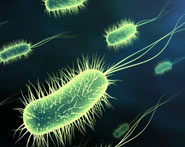


 النبات
النبات
 الحيوان
الحيوان
 الأحياء المجهرية
الأحياء المجهرية
 علم الأمراض
علم الأمراض
 التقانة الإحيائية
التقانة الإحيائية
 التقنية الحيوية المكروبية
التقنية الحيوية المكروبية
 التقنية الحياتية النانوية
التقنية الحياتية النانوية
 علم الأجنة
علم الأجنة
 الأحياء الجزيئي
الأحياء الجزيئي
 علم وظائف الأعضاء
علم وظائف الأعضاء
 الغدد
الغدد
 المضادات الحيوية
المضادات الحيوية|
Read More
Date: 19-10-2015
Date: 13-10-2015
Date: 23-10-2015
|
Blood Clotting
Blood clotting (coagulation) is the process by which blood vessels repair ruptures after injury. Injury repair actually begins even before clotting does, through vascular spasm, or muscular contraction of the vessel walls, which reduces blood loss. Clotting itself is a complex cascade of reactions involving platelets, enzymes, and structural proteins.
Platelets are not whole cells, but rather small packets of membrane- bounded cytoplasm. There are approximately one million platelets in a drop of blood. Damage to the lining of a blood vessel (the endothelial lining) exposes materials that cause platelets to stick to the endothelial cells; additional platelets then stick to these. These aggregating platelets release factors that promote accumulation of fibrin, a circulating protein. A blood clot is a meshwork of platelets and blood cells woven together by fibrin.
Accumulation of fibrin must be tightly regulated, of course, to prevent clot formation where there is no wound. Thrombosis is an abnormal localized activation of the clotting system. Disseminated intravascular coagulation is a pathological condition in which the clotting system is activated throughout the circulatory system in response to bacterial toxins, trauma, or other stimuli. A clot may break off, forming an embolus, which can lodge in a small blood vessel, cutting off circulation. If this occurs in the heart, it may cause ischemia (lack of blood flow) or myocardial infarction (heart attack). In the lungs, it causes pulmonary embolism, with loss of capacity for oxygen exchange. In the brain, it can cause stroke.
Because of this need for tight regulation, and the need for rapid response, the clotting mechanism involves a multistep cascade of enzymes, most of whose jobs are to activate the next enzyme in the cascade. In this way, the effect of the initial stimulus (the damaged blood vessel) can be quickly magnified, as a single enzyme at the first stage activates many copies of another enzyme at the next stage, each of which activates many more at the next, and so on. At the same time, the many levels of interaction provide many points of control over the process. This coagulation cascade begins from thirty seconds to several minutes after the injury.
Coagulation can begin with either of two pathways, called the extrinsic and intrinsic pathway, both of which feed into a common pathway that completes the process. The extrinsic pathway begins with a substance called tissue factor (tissue thromboplastin) released by damaged blood vessels and surrounding tissues. In the presence of other plasma proteins (clotting factors) and calcium ions, this leads to the activation of a protein called factor X. The intrinsic pathway begins with a substance called factor XII, released by blood platelets. Through a series of additional clotting factors, and again in the presence of calcium ions, this pathway also leads to the activation of factor X. One of the necessary factors of the intrinsic pathway is called factor VIII. A mutation in the gene for this factor is the most common cause of hemophilia.
The common pathway begins with the activation of factor X. In the presence of calcium ions and other clotting factors, factor X activates an enzyme called prothrombin activator. This enzyme them converts the plasma protein prothrombin into thrombin. Thrombin is an enzyme that, in turn, converts fibrinogen to fibrin. Here the cascade ends, because fibrin is not an enzyme, but a fibrous protein. It forms strands that stick to the platelets and endothelial cells at the wound, forming a meshwork that, in turn, traps other cells.
Once the clot forms, contraction of the platelets pulls the edges of the wound closer together, and fresh endothelial cells then grow across it, repairing the damaged blood vessel. Over time, fibrin is degraded by plasmin. This enzyme is formed from circulating plasminogen by tissue plasminogen activator (t-PA). Synthetic t-PA is used to dissolve blood clots in stroke, myocardial infarction, pulmonary embolism, and other conditions.
References
Guyton, Arthur C., and John E. Hall. Textbook of Medical Physiology, 10th ed. Philadelphia, PA: W. B. Saunders, Co., 2000.
Stiene-Martin, E. Anne, Cheryl A. Lotspeich-Steininger, and John A. Koepke. Clinical Hematology: Principles, Procedures, Correlations, 2nd ed. Philadelphia, PA: Lip- pincott Williams & Wilkins, 1998.



|
|
|
|
التوتر والسرطان.. علماء يحذرون من "صلة خطيرة"
|
|
|
|
|
|
|
مرآة السيارة: مدى دقة عكسها للصورة الصحيحة
|
|
|
|
|
|
|
نحو شراكة وطنية متكاملة.. الأمين العام للعتبة الحسينية يبحث مع وكيل وزارة الخارجية آفاق التعاون المؤسسي
|
|
|